Over the last two years, the Nintendo Switch has grown into somewhat of a JRPG machine. We’ve had the likes of Xenoblade Chronicles 2, Shining Resonance, Valkyria Chronicles 4 and Ys VIII to name a few. Not to mention the glorious return of Final Fantasy at the beginning of this year.
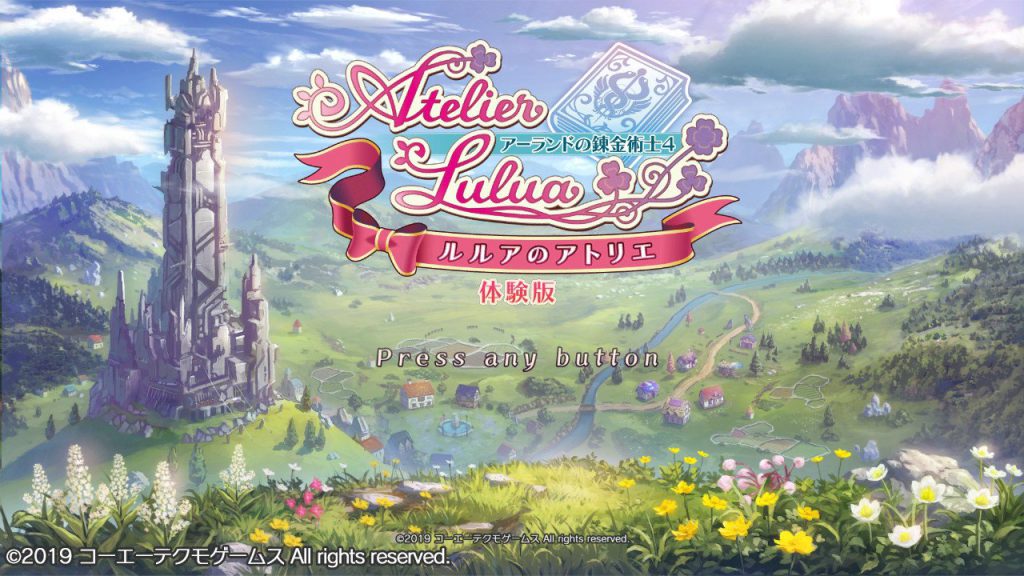
Atelier Lulua will be released simultaneously on the Switch, PS4 and PC (Steam).
With all the JRPGs vying for attention, I’d like to highlight a particular JRPG coming out soon, on 24th May 2019. Atelier Lulua: The Scion of Arland is a sequel to the beloved “Arland” trilogy of games, which itself is part of a long-running “Atelier” series of RPGs, developed by Gust.
The Atelier series isn’t a stranger to Nintendo consoles, but it has been absent for quite some time. Lately it’s been making a comeback though. The previous most recent title, Atelier Lydie & Suelle was ported to the Switch in early 2018. Meanwhile the Arland trilogy was also ported during the tail end of 2018.
Anyway, this new title follows the exploits of one Elmerulia Frixell (aka Lulua), who’s an up-and-coming young alchemist like her mother–the famous Rorona (the protagonist of the first Arland title). Despite being a sequel, the game looks to be a solid entry-point for new players or lapsed fans.
Note: This article is based on the Japanese demo, which lasts around 3-4 hours.
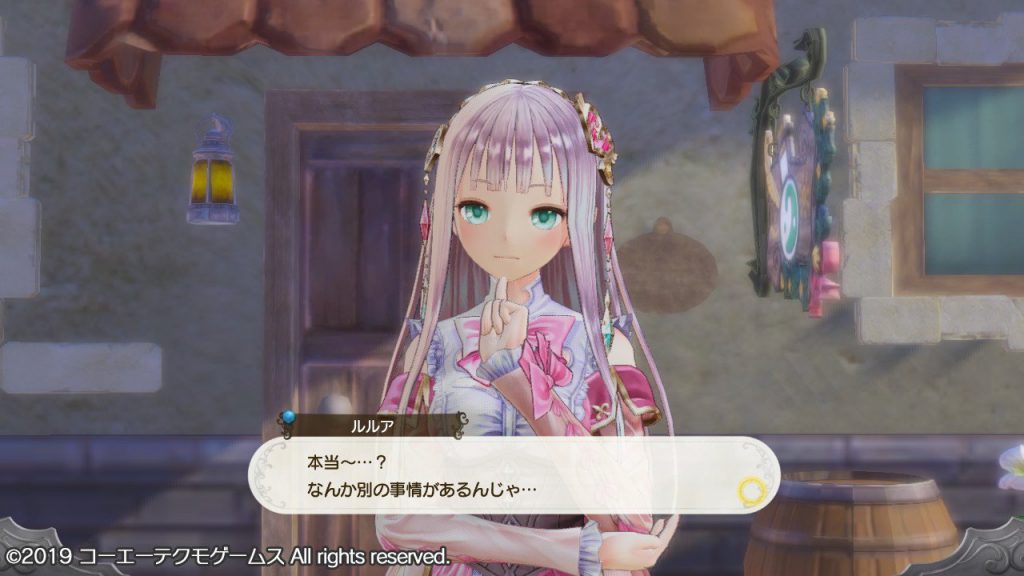
Lulua is a lively and somewhat reckless girl, but she’s positive and hard-working.
The story goes that Lulua is studying to become an alchemist–much like most of the other protagonists in the series. One day, after completing a request in an ancient ruin, she discovers a mysterious book–the “Alchemy Riddle”–that only she can read, which contains riddles that guide her future.
Afterwards, Lulua receives an official letter from the Kingdom of Arls warning that her mother’s atelier (workshop) will be shut down if she doesn’t apply for a license renewal. However, as luck would have it, her mother is currently away. Thus, Lulua and her friends embark on a journey to Arland to set things right.
The main thing that sets the Atelier games apart from other JRPGs is that you’re not playing as some angsty teen who’s destined to save the world from an ancient evil or villainous emperor. Instead, you’re a happy-go-lucky girl in a wonderfully frilly dress, trying her darnedest to keep her atelier open and running.
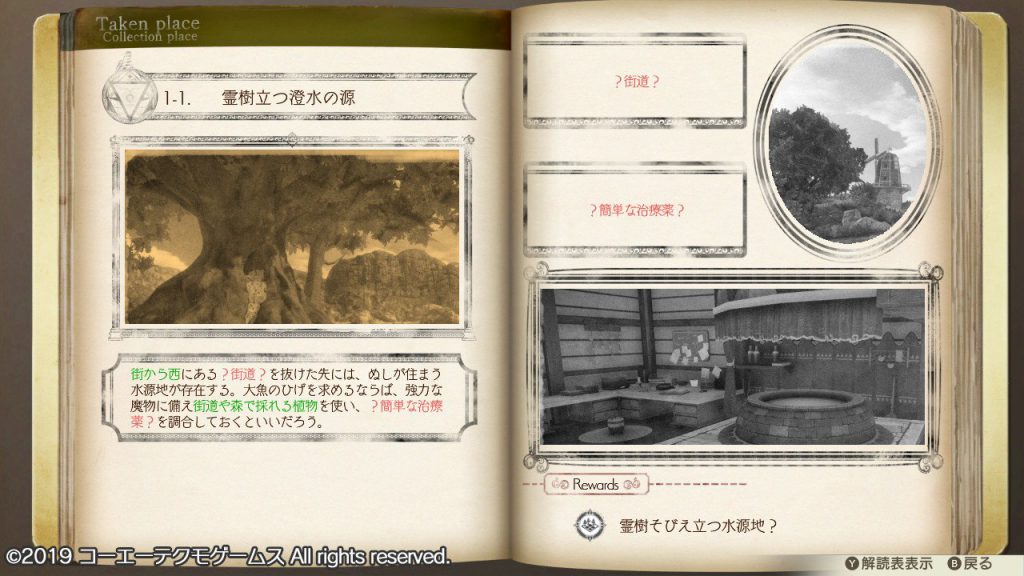
The Alchemy Riddle will automatically update as you discover the missing keywords.
While your atelier hasn’t been closed down, the core gameplay revolves around completing given tasks–this time, via the Alchemy Riddle. This cryptic book contains many half-filled pages with keywords missing. Your mission is to complete all of the pages belonging to the main story; there are also pages for sidequests.
Solving the keywords can require anything from exterminating a monster, reaching a location or finding a material etc. There will be clues in the text, as well as pictures. Once you’ve found all of the keywords, you can decipher the page back at Lulua’s workshop and learn a new alchemy recipe or receive some other reward.
To use a recipe, you’ll need the relevant ingredients (materials). These can be gathered from the various wildernesses located in the Arland region. Likewise, you’ll need to explore these wildernesses to search for clues to decipher the Alchemy Riddle. Well, are you ready to go out and do some adventuring?
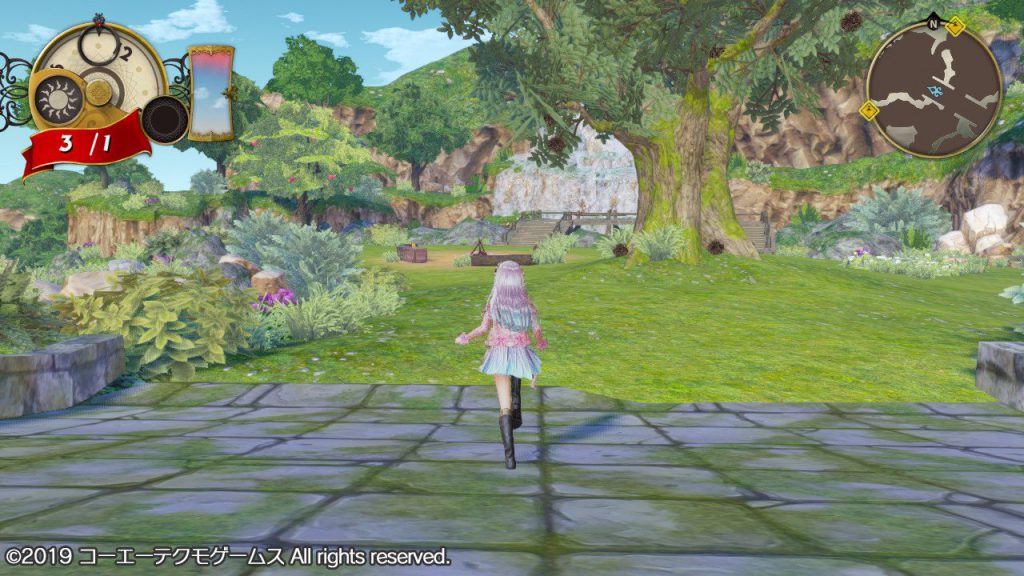
Arland seems like a colourful and welcoming place, but there are monsters roaming around.
When exploring, you control Lulua directly in full 3D environments. These include towns, like the one you start off in, highways and forests etc. After leaving town, you can visit specific locales by selecting them from the world map screen. There is an in-game calendar, which advances as you keep playing and the further you travel.
Monsters are a common sight when exploring–and that’s where we encounter another significant difference. Lulua herself isn’t really a powerful fighter, at least not early on. That makes sense since she’s an alchemist–a magical scientist–by trade. So you don’t want to be relying on her for fighting.
Instead, you must team up with hired swords, such as Aurel, a traveling knight-in-training. These characters, being professional combatants, have significantly higher combat stats and thus shoulder most of the fighting. In a way, this makes the battles feel more realistic–unlike other RPGs where 10-year kids can smite foes with giant battle axes.
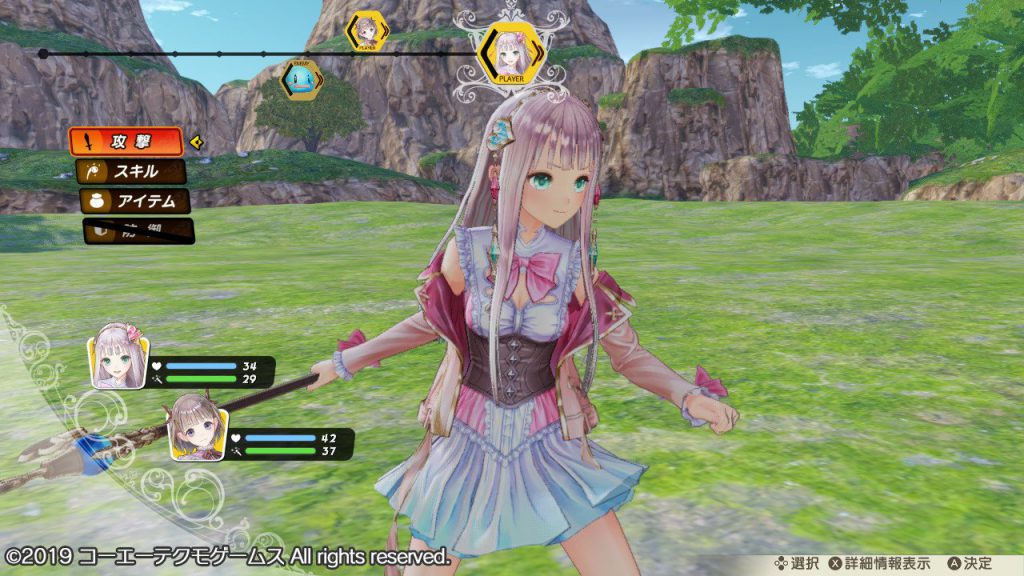
Up to three characters can actively fight, with two more functioning as support characters.
Although Lulua may not be much of a fighter, she’s not useless in battle–far from that. As an alchemist, she can deal magical damage and provide various buffs, like MP recovery for the party. Most importantly, only she (and other alchemists) can use items. Which, if you’ve played a RPG before, is a pretty big deal.
Battles against monsters are turn-based and you can view the order of your characters and your foes via a timeline in the top-left corner. When it’s a character’s turn, you can choose to attack normally, use a skill, defend or escape. Alchemists also have the privilege of using items, as mentioned above.
Strangely, the difficulty curve resembles a steep but low plateau early on. The very first enemies you fight are 10 Levels higher than you–and your characters take massive damage from attacks. Perhaps this is to discourage fighting before you get a proper warrior in your party. Afterwards, as you level up, the battles become almost too easy.
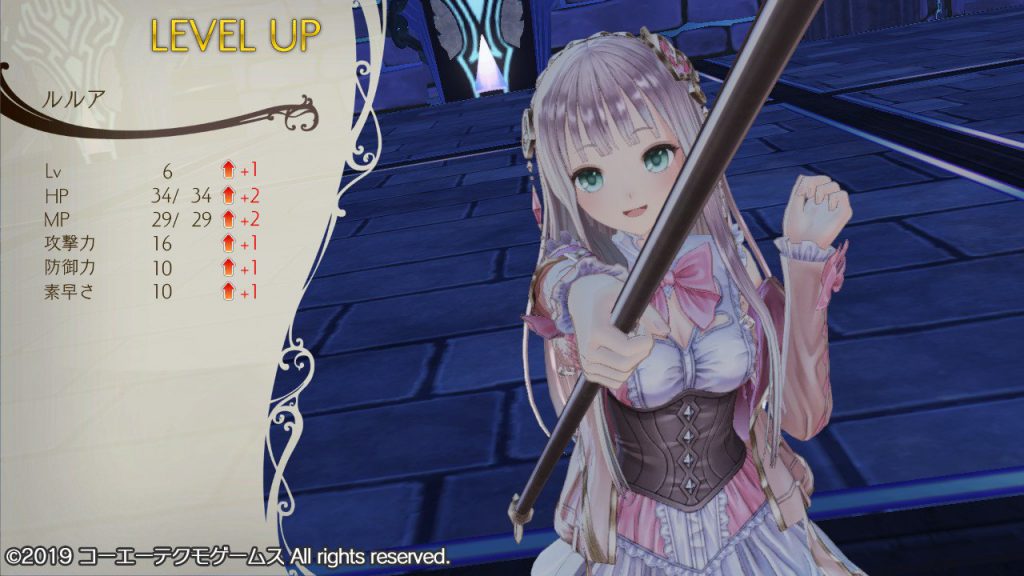
When characters Level Up, their HP, MP, Attack, Defence and Speed may increase.
On top of that, the game is very forgiving. Any characters who reach 0 HP will have 1 HP when you leave battle, so you rarely need any reviving items–just a standard healing item will do. Also, if all characters reach 0 HP at the same time, you don’t get a Game Over, but you’re taken back to the atelier with some of your gathered items missing.
There’s also no need to go to an inn and fork out cash to restore your characters. As soon as you return to town, you’ll start off at your atelier with full HP and MP. Even before you go back home, you can choose to rest on the world map–the longer you rest, the more HP and MP recovered.
All of this means the game could end up being pretty easy, although this is only based off the beginning of the game. Who knows, maybe the later dungeons will make you crying for help, or at least will provide a significant challenge. For now, it does make the game pretty relaxing to play, which is refreshing in its own right.
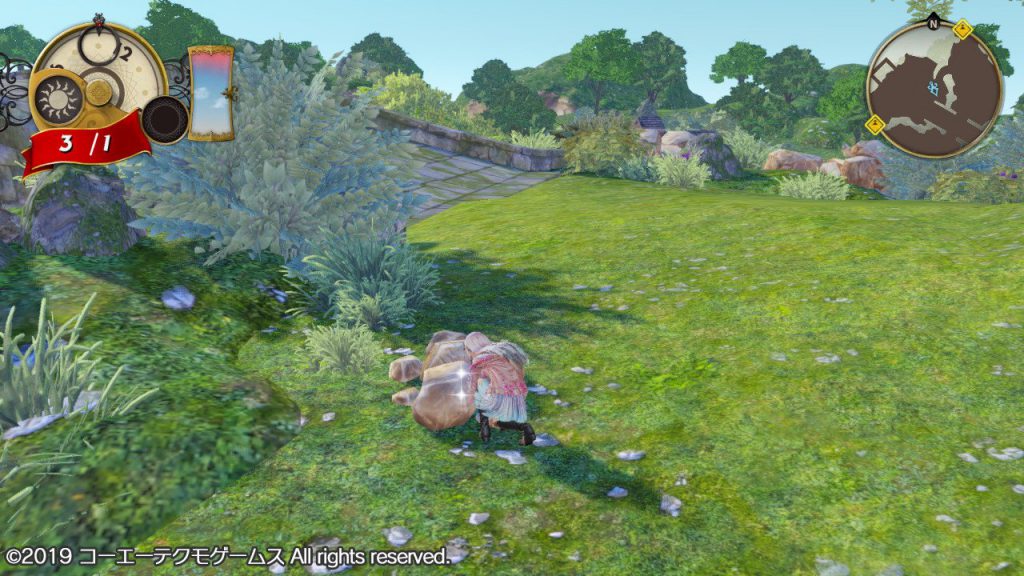
Alchemists are encouraged to do their own field work, but you can buy some ingredients from shops too.
When the coast is clear, you can gather items from a plethora of harvesting spots, indicated by glowing sparkles. These items can be used for alchemy back at your workshop. You’re encouraged to grab pretty much everything you see–and all items are placed in your cargo, which is kind of like a big item basket.
But since it’s still a basket, there’s a limit to how many items you can carry. Eventually, when it gets full, you’ll need to go back to the workshop to store them in the (much larger) item bank. However, if you get defeated by an enemy mob before that happens, you can kiss goodbye to some of your items. So you’ll need to be mindful as you explore.
Having acquired all the materials you need, it’s crafting time! This is done by approaching the cauldron in Lulua’s atelier. First you choose a recipe, then the materials you wish to use. Unlike crafting in many other games, most of the materials you need don’t have to be exact–you may be asked for minerals, which can be various types of minerals for example.
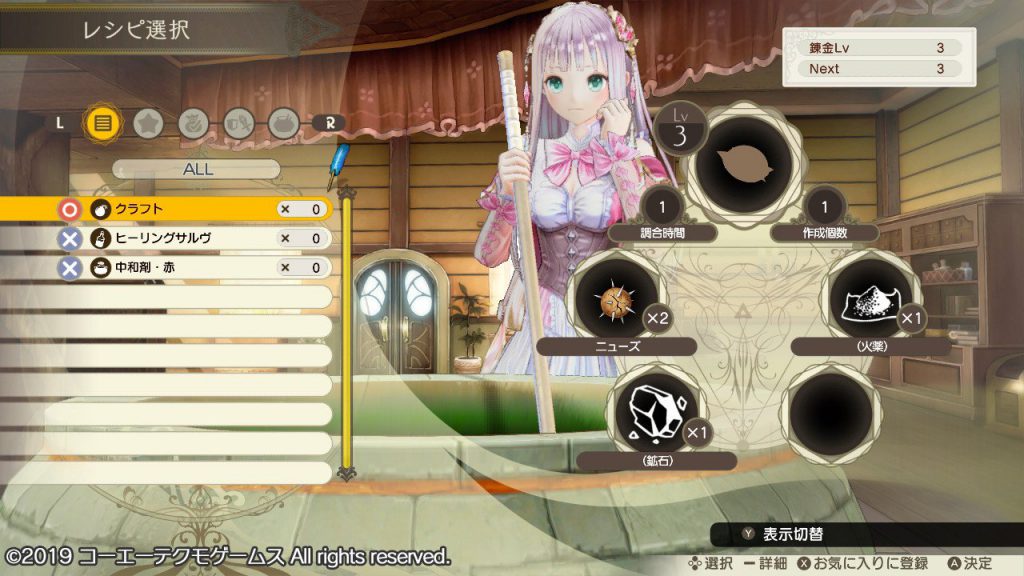
The more you craft, the more experience you earn towards increasing your Alchemy Level.
The exact materials you choose will influence the final product in many ways. At the beginning, it doesn’t matter too much what you chuck in, so long as you can make the thing. Later, you may want to pay attention to the quality and properties of each material, as well as their elemental (fire, water, earth, wind) composition.
Otherwise, the rest of the game is going around the towns and villages and interacting with the townsfolk there. As well as your ever-growing band of friends. Dialogue scenes use the character’s 3D models and are fully voiced, unless you’re talking to an unimportant NPC. At the time of writing, it seems the game will only be voiced in Japanese.
From the 3-4 hours I played, I had a lovely time with the game–and I couldn’t wait to begin trekking to the Kingdom of Arls. Watching the trailers, it looks like there’ll be much to do and many people to see, new and old. I imagine the game won’t end up breaking any new ground, but it’s probably going to be a fun and chill game to while away the hours.
Before I go, here’s a brief video of some gameplay near the end of Chapter 1. The dialogue is all in Japanese, but you can probably imagine (or pretend) what they’re saying from the context. Basically, Lulua is trying to fish for a specific material, but she accidentally reels in an angry fish monster. The game can be pretty whimsical like that!